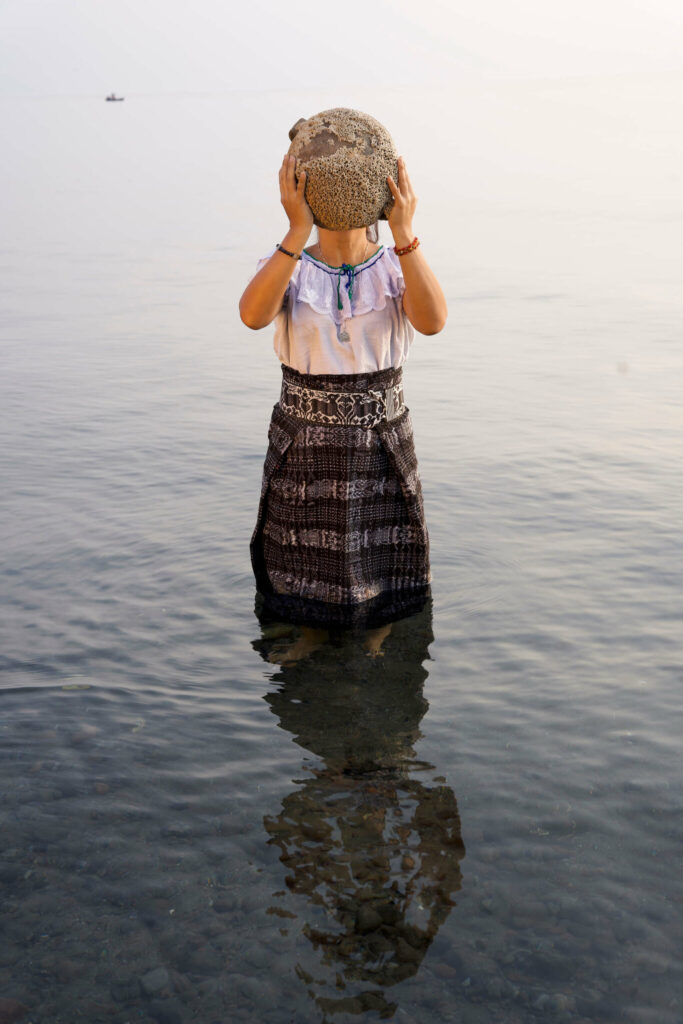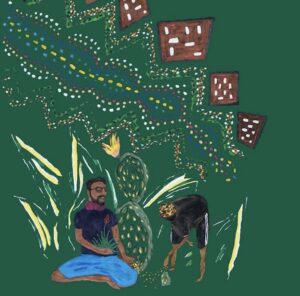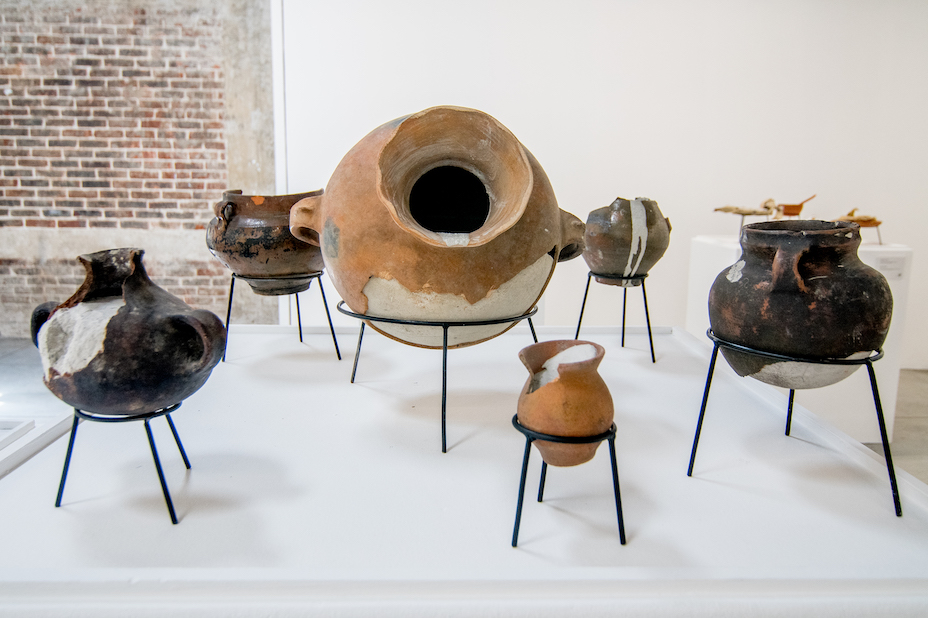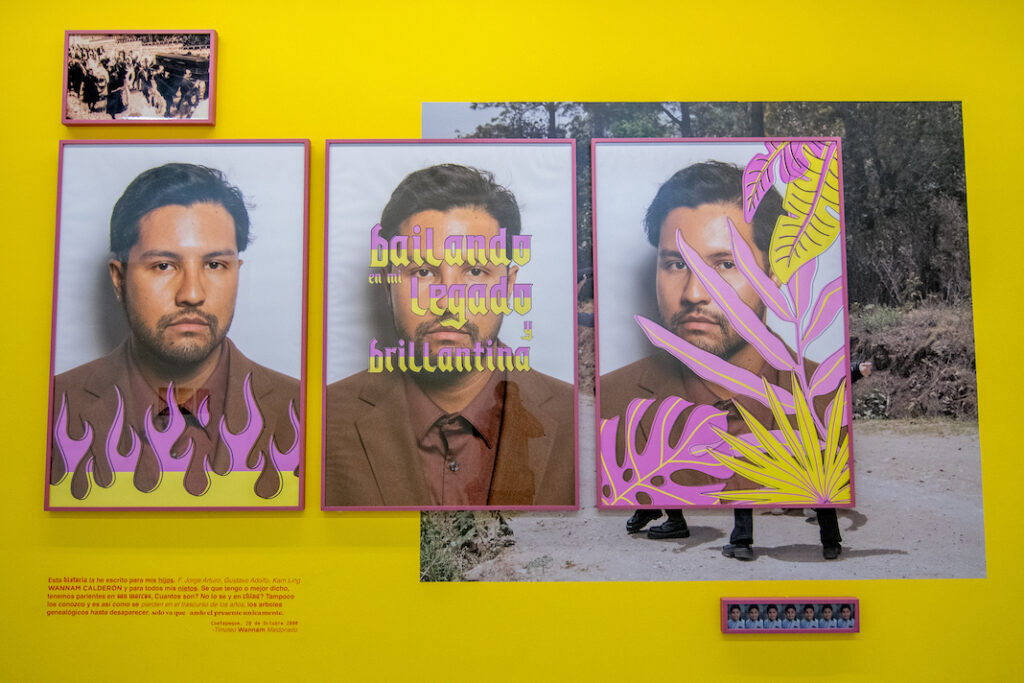Reports - Entrevista - Guatemala Latinoamérica
Reading time: 14 minutes

20.11.2023
We conducted this interview in the context of the XXIII Paiz Art Biennial held from July 13 to 30; “bebí palabras sumergidas en sueños” curated by Francine Birbragher-Rozencwaig and Juan Canela, we met to chat about their expectations, challenges and ways of carrying out the latest edition of one of the most important biennials in our region.

In the context of the XXIII edition of the Paiz Art Biennial held last July in Guatemala, we had the opportunity to speak with Maria Regina Paiz, Lucrecia Barrientos and Magui Medina from the Paiz Foundation, as well as with Francine Birbragher-Rozencwaig and Juan Canela, who together with a curatorial council made up of Duen Sacchi, Minia Biabiany, Marilyn Boror Bor and Juana Valdes, were in charge of the aesthetic-political plot of this year’s edition. Held from July 13 to 30 and with a public program that ran from March 30 to July 30, feminism, gender, memory, language, territory and poetry were the themes that circulated in the 2023 edition.
Embracing the process of developing a biennial under almost zero conditions for artistic production, without support from state institutions, is almost as complex as assuming that the racial or colonial structure is cracking from the logic of representativeness, the neoliberal market, or isolated language. With artistic proposals from more than 10 countries, the last edition proposed assuming poetry as a battlefield for the vindication of difference.
Terremoto: How did the idea of having a curatorial council for this edition of the Biennial come about?
Juan Canela: The idea of having a curatorial council made up of artists arises from wanting to understand how to work with artists from a curatorial perspective. One of the things that was interesting to us after talking with Francine was that we thought it was important to challenge the idea that there are curators who are very clear about what the project is going to be, they develop it and then call the artists. In our case, it was more about having a first idea, approaching it from intuition and starting to call the artists. This is how I work, I start to call artists that I know are working on certain topics, and with whom I already have relationships, and once the project is taking shape I invite more artists. This allows for a conjunction of conversations in the end with diverse artists and repertoires.
The curatorship is shared; it is never just one person doing things or developing projects, even when you are writing at home, because you are writing from what you are thinking about someone else’s work. So this curatorial assembly was a way to make this manner of working visible, since many times artists are part of the conceptual development of the discourse and structure of projects. On the other hand, we felt that the topics we were working on were topics in which it was important to involve other people from different geographies, identities and territories to accompany us on that path. It was there when we called Juana Valdes, Duen Sacchi, Minia Biabiany and Marilyn Boror.

Francine Birbragher-Rozencwaig: Furthermore, the entire construction is anchored to an impact outside the geographical limits of Guatemala, but with the awareness that it is a project for Guatemala. That’s where that idea also comes from. Finally, there are four artists that both Juan and I had worked with.
JC: Knowing that the knowledge we had of Guatemala was minimal, we made a point of trying to understand and talk to the people and artists we knew in the country. Then we started taking trips and that’s where the idea of working with language, the body and the territory arose. Guatemala is a country with enormous cultural and linguistic diversity based on the Mayan peoples, which are extremely important for the development of its culture. So it was that we began to think about how language and territory are related or affected by one another, how territory has to do with language, how language comes with territory, and, in that analysis, the body appeared.
FBR: Furthermore, in the Mayan worldview, body and territory are united. We already had the intuition that we had to work with language, body and territory, and that this had to be deeply rooted in Guatemala.
T: How was the process of approaching the participating artistic proposals for this edition?
FBR: Something important that we must mention is that the Paiz Foundation generates its own call, which had the innovation of opening itself to artistic expressions other than the plastic arts. Because, previously, the call was only for plastic artists and that was very restricted, since art goes far beyond a category limited to techniques or supports.
It is the first time in the history of the Paiz Biennial that there are around 84 proposals, including poetry, dance, theater, textiles, as well as many other expressions that have no place within Western language and understanding. For example, the Mayan healing ceremony that was presented cannot be reduced to performance, nor can initiation ceremonies, which have a spiritual background; they are ancient traditions that share a creative aspect but should not be pigeonholed by Western linguistic understanding.
The Foundation received around eighty proposals from that same plurality; and also, for the first time, it was opened to a much broader field, not only for local artists, but also for the Guatemalan diaspora from different parts of the world. For this reason, we decided to leave eight local proposals and we made room for artists from the diaspora, as well as other proposals from around the world that were linked in one way or another to Guatemala.
Another thing that must be highlighted in this edition is that, for the first time, the proposals presented were not anchored to the center of the country. That was a job that Juan carried out when he traveled to the Lakes region, accommodating projects that are not exactly familiar with the calls, or with the language that is mobilized from the Biennial.
Once we selected the artists from Guatemala, we began to think about who could dialogue with these proposals, so we invited the Ixqcrear collective, whose work was not intended for an artistic medium, but from a much more involved relationship with its people, just like the work of Ana Mendieta. The dialogue is strong and impressive, but above all very valid. It should be noted that we do not work based on the work itself but on the artists; that is to say, we focus more on knowing which artist could dialogue with whom before thinking directly about the work. These dialogues began on Zoom; they were conversations that took place with each of the artists around their interests and motivations, so we understood their enthusiasm as a possibility from which we could propose a certain integration.
In this sense, the artists who participated had no contact with Guatemala; but, after our conversations, they began to become more and more interested. Without trying, we now have a great variety of artists, both in terms of generation and gender, as well as territorial origin.
JC: Exactly. Additionally, there was a very strong presence of both language and poetry, both present in the exhibitions and in the catalogue.
FBR: Of course, and in that sense, we did not have an essay as such, but rather a curatorial text with a much more poetic tone.
Now, regarding the bridges that we have worked on for this edition, it is important that we talk about the collaboration with TBA211, where the curator Yina Jimenez Suriel will be doing this project for the next two years. From the TBA21, they have been researching some geographical areas of the world, especially Central America and the Caribbean, working around volcanoes.
JC: Yina had told me that they were about to go to Guatemala, before they passed through Livingston, so it seemed like a good idea to invite them and bring the two projects together. Although they are completely different proposals, there are some common points that we thought necessary to highlight.
That was also part of what we organized in the local context. Galleries being able to add what they were doing to our website is something that had never happened before. This helped visitors enjoy everything there is about culture and art in this country, so I think we are being that uniting force to generate this community around art.
T: Of course. So this is a biennial of beginnings, or a pioneer in the expansion of relationships with other artistic spaces that were active during the days in which the Biennial occurred?
FBR: And in that sense, we have not talked about the pioneers, who were an important starting point for the construction of the Biennial. It is important to know that what is being done today does not come from nowhere: there is a genealogy, especially of female artists, who at the time opened up those paths. Although there are some proposals that are better known, there are others that are not visible. For example, the case of Maria Thereza Negreiros shares the situation that many women artists experienced until the end of the 20th century, where, for various reasons, they were not seen and did not have the possibility of being exhibited. Maria Thereza was born in (Maues) the Amazon, and her first creative experiences began when, as a child, she was sent to a small town to live with the nuns. Born in the fifties into a very poor family, she began to study art. There, she meets her husband and, for circumstantial reasons, she travels to Colombia, where she begins to make contemporary art. Later, her father died and she returned to the Amazon.

When she returns, she finds a terrible situation and says: “I can’t ignore this, I have to tell the world that they are destroying the Amazon.” Then she begins to paint large abstract canvases, with vibrant colors that reflect the Amazon and the fires. In the art world, they turn their backs on her, questioning her creativity for painting landscapes. Negreiros locks herself away for decades without showing anything to the world. She is now 94 years old and paints every day. Finally, in 2008, Miguel Gonzalez put on her first exhibit. So, when we talk about language, body and territory, it is necessary to give her a well-deserved recognition as one of the pioneers.
JC: Yes, recently we also talked about Fina Miralles, who is not that well known either. She is a Catalan artist from the 70s who began to take very simple actions in nature, but with a large presence within the institutional artistic circuit. One day, she finally got tired and came to the Americas for several years. After a while, she donated all her work to a small museum in Sabadell. Several years passed before she returned to painting and performance. She currently lives in Cadaques, and just last year, she had an exhibition in Malaga. Although Fina’s work has not been as recognized as in the case of Ana Mendieta or Cecilia Vicuña, her work is now considered part of that genealogy of pioneering women in art.
With Cecilia, for example, there was a time when her work was not taken into account as much as it is now, so she began to give away her paintings to friends and acquaintances, who are now being invited to lend her work to exhibitions. Now, for the Biennial edition, she presents us with an unpublished text, a rereading of the Popol Vuh. Furthermore, she has been very involved in the entire process of the biennial. During the preparation, she sent us pages from a magazine that was published in the seventies and had a lot to do with the things we show around linguistic plurality. This was something that we decided to take into account even when designing the catalog, which is why the pages show the artists’ native language accompanied by translations.
T: What is the situation with the media like? We realize that there is a certain co-opting and little freedom of expression is perceived. At some point, did you talk about it internally to echo the political moment that Guatemala is going through?
JC: I think it’s more from the Biennial to the outside, because on the inside we have never stopped doing everything we need. The political situation, on the other hand, is something that is possibly always going to be evident; that is to say, many of the artists who participated have a very clear political stance. However, I do not believe that there is a direct position with what happens in the context of the Biennial, or much less a clear institutional critique. Rather, poetry always remains as a tool to be used. The project did have a contextual positioning, and it did propose a place of meeting and dialogue based on differences, and from that place, the political positioning is also established.
T: Isn’t it complex to think that the Paiz Biennial has not stopped under any context while the possibility of life is assumed as an ethical principle? That is, what are the things that are prioritized when preparing a biennial? What are the elements that are discarded or outsourced in an event like this?
JC: First, I do believe that it is important to take a position when it comes to political conditions in which social life is in crisis; that is very complex, and we even experienced it during the time when the Biennial was taking place, especially due to the political context and the election period in which it seemed that the right would once again take center stage. In that sense, I believe that we, not only as curators, but also as a collective in which all artists participate, cannot stand idly by when faced with the reappearance of fascist positions, to say the least.
FBR: There are many things that we cannot see that are happening. For example, coups d’état, natural disasters, or any type of actions that can definitely take us by surprise.
Paiz Foundation: Such is the case of the pandemic, for example. We had to postpone, and by postponing, we fell into election season and that was never part of the plan.
T: In that sense, how is the Biennial rearticulated with respect to communication with the visiting public after the pandemic?
JC: I would like to comment on something that I believe was also extremely important for the Biennial and its articulation outwards. The shared knowledge, that is, the pedagogical program, was where all these ways of understanding, thinking and creating together with others became possible, since they not only came into contact with communities in Guatemala but also with specific groups, such as the case of Sallisa Rosa, who worked with an artisan community. These articulations from the pedagogical program also provided an extremely important reinforcement regarding how the different artistic proposals are socialized.
FP: I think it is important to understand that the issue of education becomes complex when the government project itself underestimates its potential and ignores the possibilities of strengthening it through art. In this sense, saying that we do not have support from the State is also a multiple challenge, since we find ourselves facing the fact that children, for example, are much more disconnected from artistic possibilities, since the Ministry of Culture and Education has eliminated the possibility of providing any type of material that could encourage the building of said bridges. Also, in this way, the idea that art belongs to high culture, or that it is completely elitist, continues to be reinforced.

T: One of the great challenges that most art events on our continent possibly face—mainly in our context and due to the different social, political and economic scenarios we go through—is negotiation with the State and its institutions, where the main mobilizing ideals become networks to be able to filter out what needs to be put in, while aspects such as cultural valorization and the role of education and political commitments become the battlefield against ideals that are nourished by conservative, fascist and antidemocratic ideas. Last July, Guatemala was going through a critical moment where democracy was made vulnerable by the advancement of the far right and its manipulation under the scheme of orchestrated legality. Three months have passed and the coup d’état is more than present; the country has been called for a national strike by different groups, farmers and organized groups of different indigenous peoples.
There is no way to deny the involvement of the art world in the sociopolitical contexts that circumscribe the different practices that shape what we can call—perhaps in the most radical way possible, and quoting the anticolonial activist Frantz Fanon—: the commitment to the Lived Experience. This is what can give strength to the dynamics of resistance in contexts of high vital vulnerability.
[1] Thyssen-Bornemisza Art Contemporary (TBA21).
23.03.2024
Opinion Cartografía sentimental de la brutalización en curso Argentina, Latinoamérica
Duen Sacchi
22.03.2024
Marginalia
(Español) La Revuelta
08.03.2024
Opinion
María Galindo
Comments
There are no coments available.